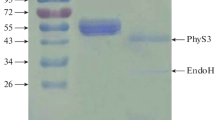Abstract
A novel phytase gene, appA, was isolated by degenerate polymerase chain reaction (PCR) and thermal asymmetric interlaced PCR from Dickeya paradisiaca. The full-length appA comprises 1278 bp and encodes 425 amino acid residues, including a 23-residue putative N-terminal signal peptide. The deduced amino acid sequence of appA reveals the conserved motifs RHGXRXP and HD, which are typical of histidine acid phosphatases; significantly, APPA shows maximum identity (49%) to a phytase from Klebsiella pneumoniae. To characterize the properties of APPA, appA was expressed in Escherichia coli and purified. The purified recombinant APPA has two pH optima at pH 4.5 and 5.5, optimum temperature at 55 °C, specific activity of 769 U/mg, and good pH stability. The K m value for the substrate sodium phytate is 0.399 mM with a V max of 666 U/mg. To our knowledge, this is the first report of a phytase or phytase gene isolated from Dickeya.





Similar content being viewed by others
Abbreviations
- HAP:
-
histidine acid phosphatase
- IPTG:
-
isopropyl β-d-1-thiogalactopyranoside
- r-APPA:
-
recombinant APPA
- TAIL-PCR:
-
thermal asymmetric interlaced PCR
References
Reddy, N. R., Sathe, S. K., & Salunkhe, D. K. (1989). Advances in Food Research, 28, 91–92.
Mullaney, E. J., Daly, C. B., & Ullah, A. H. (2000). Advances in Applied Microbiology, 47, 157–199. doi:10.1016/S0065-2164(00)47004-8.
Lei, X. G., Ku, P. K., Miller, E. R., Yokoyama, M. T., & Ullrey, D. E. (1993). Journal of Animal Science, 71, 3368–3375.
Simons, P. C., Versteegh, H. A., Jongbloed, A. W., Kemme, P. A., Slump, P., Bos, K. D., et al. (1990). British Journal of Nutrition, 64, 525–540. doi:10.1079/BJN19900052.
Lei, X. G., & Stahl, C. H. (2001). Applied Microbiology and Biotechnology, 57, 474–481. doi:10.1007/s002530100795.
Dassa, J., Marck, C., & Boquet, P. L. (1990). Journal of Bacteriology, 172, 5497–5500.
Rodriquez, E., Han, Y., & Lei, X. G. (1999). Biochemical and Biophysical Research Communications, 257, 117–123. doi:10.1006/bbrc.1999.0361.
Kerovuo, J., Lauraeus, M., Nurminen, P., Kalkkinen, N., & Apajalahti, J. (1998). Applied and Environmental Microbiology, 64, 2079–2085.
Kim, O. K., Lee, J. K., Kim, H. K., Yu, J. H., & Oh, T. K. (1998). FEMS Microbiology Letters, 162, 185–191. doi:10.1111/j.1574-6968.1998.tb12997.x.
Tye, A. J., Siu, F. K. Y., Leung, T. Y. C., & Lim, B. L. (2002). Applied Microbiology and Biotechnology, 59, 190–197. doi:10.1007/s00253-002-1033-5.
Kim, Y. O., Kim, H. W., Lee, J. H., Kim, K. K., & Lee, S. J. (2006). Biotechnology Letters, 28, 33–38. doi:10.1007/s10529-005-9684-9.
Sajidan, A., Farouk, A., Greiner, R., Jungblut, P., Muller, E. C., & Borriss, R. (2004). Applied Microbiology and Biotechnology, 65, 110–118. doi:10.1007/s00253-003-1530-1.
Huang, H. Q., Luo, H. Y., Yang, P. L., Meng, K., Wang, Y. R., Yuan, T. Z., et al. (2006). Biochemical and Biophysical Research Communications, 350, 884–889. doi:10.1016/j.bbrc.2006.09.118.
Zinin, N. V., Serkina, A. V., Gelfand, M. S., Shevelev, A. B., & Sineoky, S. P. (2004). FEMS Microbiology Letters, 236, 283–290. doi:10.1111/j.1574-6968.2004.tb09659.x.
Cho, J. S., Lee, C. W., Kang, S. H., Lee, J. C., Lee, H., Bok, J., et al. (2005). Current Microbiology, 51, 11–15. doi:10.1007/s00284-005-4482-0.
Liu, Y. G., & Whittier, R. F. (1995). Genomics, 25(3), 674–681. doi:10.1016/0888-7543(95)80010-J.
Sambrook, J., Fritsch, E. F., & Maniatis, T. (1989). Molecular cloning: A laboratory manual (2nd ed.). New York: Cold Spring Harbor Laboratory Press.
Holman, W. I. M. (1943). Biochemical Journal, 37(2), 256–259.
Kim, H. W., Kim, Y. O., Lee, J. H., Kim, K. K., & Kim, Y. J. (2003). Biotechnology Letters, 25, 1231–1234. doi:10.1023/A:1025020309596.
Simon, O., & Igbasan, F. (2002). International Journal of Food Science & Technology, 37, 813–822. doi:10.1046/j.1365-2621.2002.00621.x.
Misset, O. (2003). Food Science & Technology, 122, 687–706.
Cho, J. S., Lee, C. W., Kang, S. H., Lee, J. C., Bok, J. D., Moon, Y. S., et al. (2003). Current Microbiology, 47, 290–294. doi:10.1007/s00284-002-3966-4.
Wyss, M., Brugger, R., Kronenberger, A., Remy, R., Fimbel, R., Oesterhelt, G., et al. (1999). Applied and Environmental Microbiology, 65, 367–373.
Chatterjee, S., Sankaranarayanan, R., & Ramesh, V. S. (2003). Molecular Plant-Microbe Interactions, 16, 973–982. doi:10.1094/MPMI.2003.16.11.973.
Acknowledgements
This work was supported by the National Basic Research Program of China (no. 2004CB719606) and the Hi-tech Research and Development Program of China (no. 2006AA020101).
Author information
Authors and Affiliations
Corresponding author
Additional information
Weina Gu and Huoqing Huang contributed equally to this work.
Rights and permissions
About this article
Cite this article
Gu, W., Huang, H., Meng, K. et al. Gene Cloning, Expression, and Characterization of a Novel Phytase from Dickeya paradisiaca . Appl Biochem Biotechnol 157, 113–123 (2009). https://doi.org/10.1007/s12010-008-8329-6
Received:
Accepted:
Published:
Issue Date:
DOI: https://doi.org/10.1007/s12010-008-8329-6




